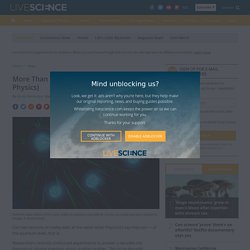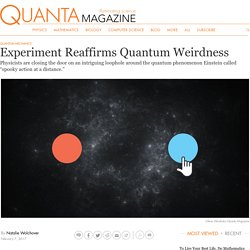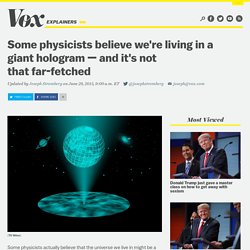

More Than One Reality Exists (in Quantum Physics) Can two versions of reality exist at the same time?

Physicists say they can — at the quantum level, that is. Researchers recently conducted experiments to answer a decades-old theoretical physics question about dueling realities. This tricky thought experiment proposed that two individuals observing the same photon could arrive at different conclusions about that photon's state — and yet both of their observations would be correct. For the first time, scientists have replicated conditions described in the thought experiment. Their results, published Feb. 13 in the preprint journal arXiv, confirmed that even when observers described different states in the same photon, the two conflicting realities could both be true.
"You can verify both of them," study co-author Martin Ringbauer, a postdoctoral researcher with the Department of Experimental Physics at the University of Innsbrück in Austria, told Live Science. Wigner's friend Altered states Originally published on Live Science. Quantum teleportation is even weirder than you think. A BBC headline last week, ‘First object teleported to Earth’s orbit’, has to be one of the most fantastical you’ll see this year.

For once, it seems the future that science fiction promised has arrived! Scientists Teleport A Photon From Earth To Orbit For The First Time. Physicists Are Closing the Bell Test Loophole. There might be no getting around what Albert Einstein called “spooky action at a distance.”

With an experiment described today in Physical Review Letters — a feat that involved harnessing starlight to control measurements of particles shot between buildings in Vienna — some of the world’s leading cosmologists and quantum physicists are closing the door on an intriguing alternative to “quantum entanglement.” “Technically, this experiment is truly impressive,” said Nicolas Gisin, a quantum physicist at the University of Geneva who has studied this loophole around entanglement. According to standard quantum theory, particles have no definite states, only relative probabilities of being one thing or another — at least, until they are measured, when they seem to suddenly roll the dice and jump into formation. In 1964, the Northern Irish physicist John Bell found a way to put this paradoxical notion to the test. Theconversation. The world of quantum mechanics is weird.

Objects that are far apart can influence each other in what Albert Einstein called “spooky action at a distance”, and cats can potentially be dead and alive at the same time. For decades, scientists have tried to prove that these effects are not just mathematical quirks, but real properties of the physical world. And they are getting somewhere. Researchers have finally proven in a new study that the link between particles at a distance reflects how the universe behaves, rather than being an experimental artefact. Meanwhile, another team of researchers have set out to show that a living creature, albeit a bacterium, can be in two different quantum states at the same time – just like the cat in Schrödinger’s thought experiment. Bell’s inequality test. Quantum physics meets genetic engineering: Researchers use engineered viruses to provide quantum-based enhancement of energy transport.
Nature has had billions of years to perfect photosynthesis, which directly or indirectly supports virtually all life on Earth.

In that time, the process has achieved almost 100 percent efficiency in transporting the energy of sunlight from receptors to reaction centers where it can be harnessed -- a performance vastly better than even the best solar cells. One way plants achieve this efficiency is by making use of the exotic effects of quantum mechanics -- effects sometimes known as "quantum weirdness. " These effects, which include the ability of a particle to exist in more than one place at a time, have now been used by engineers at MIT to achieve a significant efficiency boost in a light-harvesting system.
Surprisingly, the MIT researchers achieved this new approach to solar energy not with high-tech materials or microchips -- but by using genetically engineered viruses. That's where the virus comes in. Quantum-cognition-could-predict-irrational-human-behaviour. People’s behaviour seems irrational but is governed by quantum principles.

The brain may behave like a quantum computer to help us cope with the complexities of life, a new theory argues. Quantum cognition may help explain why people’s behaviour can often seem so irrational. Dr Zheng Joyce Wang, one of the study’s authors, said: “We have accumulated so many paradoxical findings in the field of cognition, and especially in decision-making.Whenever something comes up that isn’t consistent with classical theories, we often label it as ‘irrational.’But from the perspective of quantum cognition, some findings aren’t irrational any more.They’re consistent with quantum theory — and with how people really behave.”
Einstein’s Parable of Quantum Insanity. “Insanity is doing the same thing over and over and expecting different results.”

That witticism — I’ll call it “Einstein Insanity” — is usually attributed to Albert Einstein. Though the Matthew effect may be operating here, it is undeniably the sort of clever, memorable one-liner that Einstein often tossed off. And I’m happy to give him the credit, because doing so takes us in interesting directions. First of all, note that what Einstein describes as insanity is, according to quantum theory, the way the world actually works. World's first magnetic "wormhole" produces magnetic monopole. It may not instantly whisk you to far-flung reaches of the universe like the gravitational wormholes of Stargate, Star Trek and Interstellar, but researchers at Universitat Autònoma de Barcelona (UAB) claim to have created the first experimental wormhole that links two regions of space magnetically.

Using metamaterials and metasurfaces, the scientists for UAB's Department of Physics created a sphere that from the outside is magnetically undetectable. Is Our Universe a Fake? Robert Lawrence Kuhn is the creator, writer and host of "Closer to Truth," a public television and multimedia program that features the world's leading thinkers exploring humanity's deepest questions.

Kuhn is co-editor, with John Leslie, of "The Mystery of Existence: Why Is There Anything at All? " (Wiley-Blackwell, 2013). Some physicists believe we're living in a giant hologram — and it's not that far-fetched. (TU Wien) Some physicists actually believe that the universe we live in might be a hologram.

The idea isn't that the universe is some sort of fake simulation out of The Matrix, but rather that even though we appear to live in a three-dimensional universe, it might only have two dimensions. It's called the holographic principle. The thinking goes like this: Some distant two-dimensional surface contains all the data needed to fully describe our world — and much like in a hologram, this data is projected to appear in three dimensions. Scientists calculate the diffraction of light with quantum physics. The illustration shows the diffraction of light. The light comes from the light source on the right and is on the way to Earth (left). Between Earth and the light source is a large heavenly body, which causes the light to diffract its route towards the Earth. The orange arrows show where the light source is most likely located (seen from the Earth) while the white arrows show where the light source actually is. New quantum mechanics theory says parallel universes exist, interact.
Published time: November 04, 2014 20:16 Reuters/NRAO To the average person, quantum mechanics is the convoluted, science fiction-y branch of physics. A radical new theory plays into that, proposing that parallel universes exist and interact with each other ‒ and that scientists may be able to test for them. Prof. Howard Wiseman, a physicist at Griffith University in Brisbane, Australia, along with his collaborators Dr.
Zuse's Thesis - Zuse hypothesis - Algorithmic Theory of Everything - Digital Physics, Rechnender Raum (Computing Space, Computing Cosmos) - Computable Universe - The Universe is a Computer - Theory of Everything. Konrad Zuse (1910-1995; pronounce: "Conrud Tsoosay") not only built the first programmable computers (1935-1941) and devised the first higher-level programming language (1945), but also was the first to suggest (in 1967) that the entire universe is being computed on a computer, possibly a cellular automaton (CA). He referred to this as "Rechnender Raum" or Computing Space or Computing Cosmos.
Many years later similar ideas were also published / popularized / extended by Edward Fredkin (1980s), Jürgen Schmidhuber (1990s - see overview), and more recently Stephen Wolfram (2002) (see comments and Edwin Clark's review page ). Quantum mechanics and scientific realism. By Quentin Ruyant One of the main tasks of philosophy is to clarify conceptual problems and sketch the landscape of possible solutions to these problems. Of course, individual philosophers often tend to defend specific positions, but what emerges at the level of the community is, generally, a landscape of possibilities. Simulations back up theory that Universe is a hologram. Artist's impression by Markus Gann/Shutterstock At a black hole, Albert Einstein's theory of gravity apparently clashes with quantum physics, but that conflict could be solved if the Universe were a holographic projection.
A team of physicists has provided some of the clearest evidence yet that our Universe could be just one big projection. Bohm's Gnosis: The Implicate Order. Midwest Real Podcast #058 Everything is Sound with Alexandre Tannous, Michael Phillip. “The universe is a symphony of vibrating strings… We are nothing but melodies, we are nothing but cosmic music played out on vibrating strings and membranes.” Phys. Rev. X 4, 041013 (2014) - Quantum Phenomena Modeled by Interactions between Many Classical Worlds. We investigate whether quantum theory can be understood as the continuum limit of a mechanical theory, in which there is a huge, but finite, number of classical “worlds,” and quantum effects arise solely from a universal interaction between these worlds, without reference to any wave function. Here, a “world” means an entire universe with well-defined properties, determined by the classical configuration of its particles and fields.
In our approach, each world evolves deterministically, probabilities arise due to ignorance as to which world a given observer occupies, and we argue that in the limit of infinitely many worlds the wave function can be recovered (as a secondary object) from the motion of these worlds. An infinite multiverse: a bad idea or inescapable? Earlier this week, a cultural center in Red Hook, Brooklyn played host to the sort of debate that's usually reserved for smoke-filled dorm rooms: do we live in a multiverse and, if so, is there another you out there? But rather than mind-altered undergrads, the debate took place among three physicists, one of whom happens to have a Nobel Prize sitting back home.
Do Parallel Worlds Interact with One Another? The Engineer posted on October 31, 2014 | Comment | 792 views Griffith University academics are challenging the foundations of quantum science with a radical new theory based on the existence of, and interactions between, parallel universes. In a paper published in the prestigious journal Physical Review X, Professor Howard Wiseman and Dr Michael Hall from Griffith's Centre for Quantum Dynamics, and Dr Dirk-Andre Deckert from the University of California, take interacting parallel worlds out of the realm of science fiction and into that of hard science. Researchers achieve long-distance light to matter quantum teleportation.
New Time Travel Simulation May Resolve 'Grandfather Paradox' On June 28, 2009, the world-famous physicist Stephen Hawking threw a party at the University of Cambridge, complete with balloons, hors d'oeuvres and iced champagne. Everyone was invited but no one showed up. Fermilab experiment will attempt to answer whether we actually live in "the Matrix" Scientists introduce new cosmic connectivity: Quantum pigeonhole paradox. In the 20th century, two revolutions in physics shook the world. One of them was relativity, discovered by Einstein. Wormhole Photon Time Travel - Casimir Energy, Messages.
The basic principle behind the Search for Extra-Terrestrial Intelligence (SETI) is that we’re better off hearing from extraterrestrial intelligence than we are not hearing from extraterrestrial intelligence, but—even assuming we don’t catastrophically screw up first contact (and we may)—we have no guarantee that the alien civilization we reach will share any of our history, values, or priorities. Best Explanation of Quantum Field Theory That You Will Ever Hear, Provided by Sean Carroll in Less than 2 Minutes at the 46th Annual Fermilab Users Meeting. The Sacred, Spherical Cows of Physics - Issue 13: Symmetry. Discovery of Quantum Vibrations in 'Microtubules' Inside Brain Neurons Supports Controversial Theory of Consciousness. How To Change The Past. Predicting the unpredictable: Critical analysis and practical implications of predictive anticipatory activity.
Scientific Research Suggests We Unconsciously React to Events Up to 10 Seconds Before They Happen. The Quantum Mechanics of Fate - Issue 9: Time. #3 Parallel Worlds exist and will soon be testable, expert says. Is Earth Weighed Down By Dark Matter, Or Internet? Quantum black hole study opens bridge to another universe. Simulations back up theory that Universe is a hologram. Is The Universe A Hologram? Physicists Say It's Possible. Is there an evil, goateed version of you somewhere in the multiverse? If this theory is correct, we may live in a web of alternate timelines. Weird Quantum Tunneling Enables 'Impossible' Space Chemistry. Www.mta.ca/~rhudson/papers/turku.htm. Time Travel: Which paradox comes most close to support the possibility of Time Travel.
Time Travel: What is the most mind boggling example of a time travel paradox. The True Science of Parallel Universes. Www.onbeing.org/sites/onbeing.org/files/gates-symbolsofpower.pdf. Quantum Puzzles: Funny Things Happen When Space And Time Vanish : 13.7: Cosmos And Culture. Researcher teleports with a kitten. Vortex to another dimension reported in Brighton.
Nothing to see: The man who made a Majorana particle - opinion - 13 May 2013. Entropy law linked to intelligence, say researchers. Back to the Future 2 – Here We Come. Scientists await new worlds as CERN collider is refitted. So you think YOU'RE confused about quantum mechanics? Breaking the Speed of (Light) Thought. Controversial quantum computer aces entanglement tests - physics-math - 08 March 2013. Quantum "spooky action at a distance" travels at least 10,000 times faster than light. Weird Science (Part 2) Weird Science. Wormhole. Www.orionsarm.com/fm_store/TraversableLorenzianWormholes-Overview.pdf. Einstein to shed light on black holes. Physicists May Have Evidence Universe Is A Computer Simulation. Northwestern University & the Psi’ence of Presentiment.
Supersolidity loses its luster.